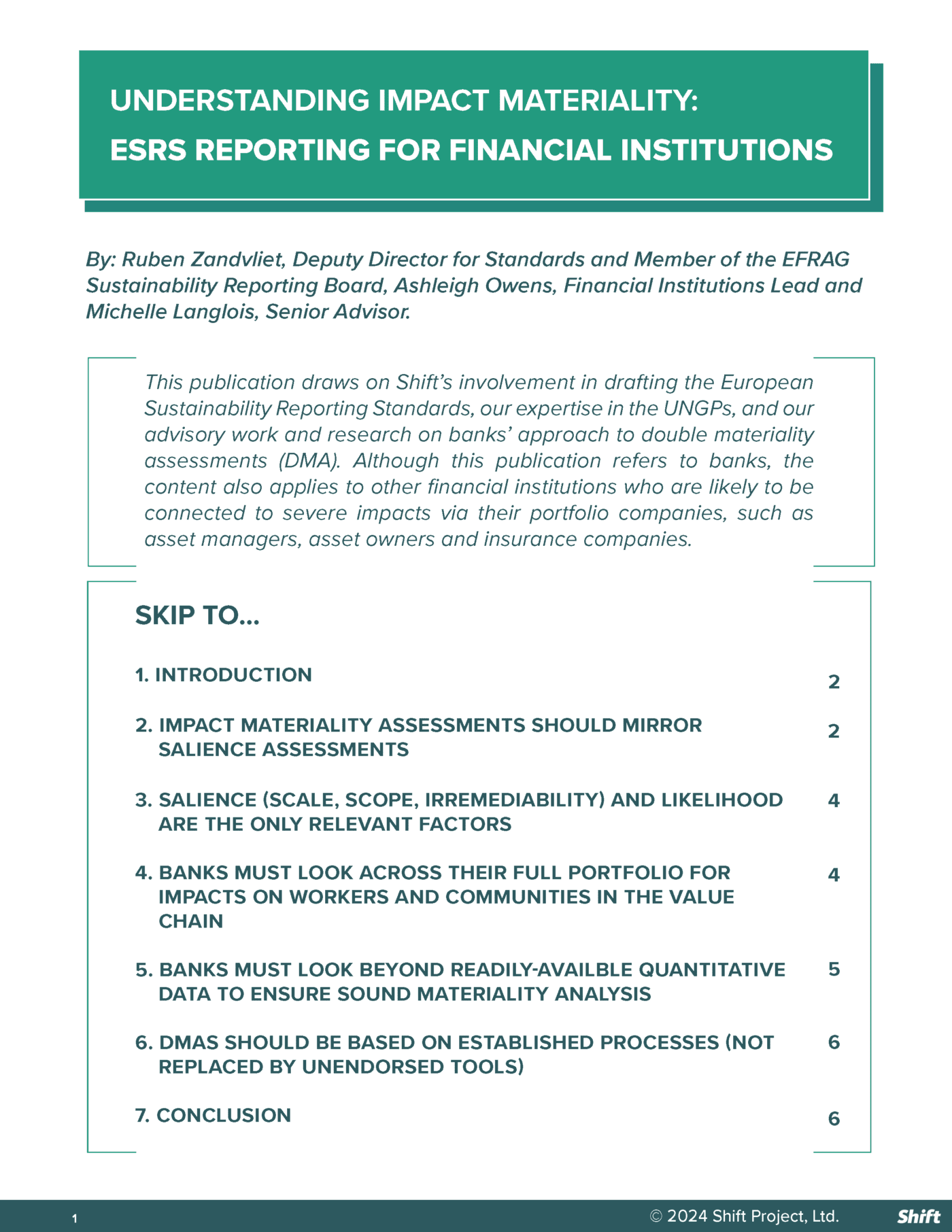Pillar 3: Access to remedy
Foundational Principle
25. As part of their duty to protect against business-related human rights abuse, States must take appropriate steps to ensure, through judicial, administrative, legislative or other appropriate means, that when such abuses occur within their territory and/or jurisdiction those affected have access to effective remedy.
___
Commentary
Unless States take appropriate steps to investigate, punish and redress business-related human rights abuses when they do occur, the State duty to protect can be rendered weak or even meaningless.
Access to effective remedy has both procedural and substantive aspects. The remedies provided by the grievance mechanisms discussed in this section may take a range of substantive forms the aim of which, generally speaking, will be to counteract or make good any human rights harms that have occurred. Remedy may include apologies, restitution, rehabilitation, financial or non-financial compensation and punitive sanctions (whether criminal or administrative, such as fines), as well as the prevention of harm through, for example, injunctions or guarantees of non-repetition.
Procedures for the provision of remedy should be impartial, protected from corruption and free from political or other attempts to influence the outcome.
For the purpose of these Guiding Principles, a grievance is understood to be a perceived injustice evoking an individual’s or a group’s sense of entitlement, which may be based on law, contract, explicit or implicit promises, customary practice, or general notions of fairness of aggrieved communities. The term grievance mechanism is used to indicate any routinized, State-based or non-State-based, judicial or non-judicial process through which grievances concerning business-related human rights abuse can be raised and remedy can be sought.
State-based grievance mechanisms may be administered by a branch or agency of the State, or by an independent body on a statutory or constitutional basis. They may be judicial or non-judicial. In some mechanisms, those affected are directly involved in seeking remedy; in others, an intermediary seeks remedy on their behalf. Examples include the courts (for both criminal and civil actions), labour tribunals, national human rights institutions, National Contact Points under the Guidelines for Multinational Enterprises of the Organisation for Economic Co-operation and Development, many ombudsperson offices, and Government-run complaints offices.
Ensuring access to remedy for business-related human rights abuses requires also that States facilitate public awareness and understanding of these mechanisms, how they can be accessed, and any support (financial or expert) for doing so.
State-based judicial and non-judicial grievance mechanisms should form the foundation of a wider system of remedy. Within such a system, operational-level grievance mechanisms can provide early-stage recourse and resolution. State-based and operational-level mechanisms, in turn, can be supplemented or enhanced by the remedial functions of collaborative initiatives as well as those of international and regional human rights mechanisms. Further guidance with regard to these mechanisms is provided in Guiding Principles 26 to 31.
Operational Principles
STATE-BASED JUDICIAL MECHANISMS
26. States should take appropriate steps to ensure the effectiveness of domestic judicial mechanisms when addressing business-related human rights abuses, including considering ways to reduce legal, practical and other relevant barriers that could lead to a denial of access to remedy.
___
Commentary
Effective judicial mechanisms are at the core of ensuring access to remedy. Their ability to address business-related human rights abuses depends on their impartiality, integrity and ability to accord due process. States should ensure that they do not erect barriers to prevent legitimate cases from being brought before the courts in situations where judicial recourse is an essential part of accessing remedy or alternative sources of effective remedy are unavailable.
They should also ensure that the provision of justice is not prevented by corruption of the judicial process, that courts are independent of economic or political pressures from other State agents and from business actors, and that the legitimate and peaceful activities of human rights defenders are not obstructed.
Legal barriers that can prevent legitimate cases involving business-related human rights abuse from being addressed can arise where, for example:
- The way in which legal responsibility is attributed among members of a corporate group under domestic criminal and civil laws facilitates the avoidance of appropriate accountability;
- Where claimants face a denial of justice in a host State and cannot access home State courts regardless of the merits of the claim;
- Where certain groups, such as indigenous peoples and migrants, are excluded from the same level of legal protection of their human rights that applies to the wider population.
Practical and procedural barriers to accessing judicial remedy can arise where, for example:
- The costs of bringing claims go beyond being an appropriate deterrent to unmeritorious cases and/or cannot be reduced to reasonable levels through Government support, “market-based” mechanisms (such as litigation insurance and legal fee structures), or other means;
- Claimants experience difficulty in securing legal representation, due to a lack of resources or of other incentives for lawyers to advise claimants in this area;
- There are inadequate options for aggregating claims or enabling representative proceedings (such as class actions and other collective action procedures), and this prevents effective remedy for individual claimants;
- State prosecutors lack adequate resources, expertise and support to meet the State’s own obligations to investigate individual and business involvement in human rights-related crimes.
Many of these barriers are the result of, or compounded by, the frequent imbalances between the parties to business related human rights claims, such as in their financial resources, access to information and expertise. Moreover, whether through active discrimination or as the unintended consequences of the way judicial mechanisms are designed and operate, individuals from groups or populations at heightened risk of vulnerability or marginalization often face additional cultural, social, physical and financial impediments to accessing, using and benefiting from these mechanisms.
Particular attention should be given to the rights and specific needs of such groups or populations at each stage of the remedial process: access, procedures and outcome.
STATE-BASED NON-JUDICIAL GRIEVANCE MECHANISMS
27. States should provide effective and appropriate non-judicial grievance mechanisms, alongside judicial mechanisms, as part of a comprehensive State-based system for the remedy of business-related human rights abuse.
___
Commentary
Administrative, legislative and other non-judicial mechanisms play an essential role in complementing and supplementing judicial mechanisms. Even where judicial systems are effective and well-resourced, they cannot carry the burden of addressing all alleged abuses; judicial remedy is not always required; nor is it always the favoured approach for all claimants.
Gaps in the provision of remedy for business-related human rights abuses could be filled, where appropriate, by expanding the mandates of existing non-judicial mechanisms and/or by adding new mechanisms. These may be mediation-based, adjudicative or follow other culturally appropriate and rights-compatible processes – or involve some combination of these –depending on the issues concerned, any public interest involved, and the potential needs of the parties. To ensure their effectiveness, they should meet the criteria set out in Principle 31.
National human rights institutions have a particularly important role to play in this regard.
As with judicial mechanisms, States should consider ways to address any imbalances between the parties to business-related human rights claimsand any additional barriers to access faced by individuals from groups or populations at heightened risk of vulnerability or marginalization.
Non-state-based grievance mechanisms
28. States should consider ways to facilitate access to effective non State based grievance mechanisms dealing with business-related human rights harms.
___
Commentary
One category of non-State-based grievance mechanisms encompasses those administered by a business enterprise alone or with stakeholders, by an industry association or a multi-stakeholder group. They are non-judicial, but may use adjudicative, dialogue-based or other culturally appropriate and rights-compatible processes. These mechanisms may offer particular benefits such as speed of access and remediation, reduced costs and/or transnational reach.
Another category comprises regional and international human rights bodies. These have dealt most often with alleged violations by States of their obligations to respect human rights. However, some have also dealt with the failure of a State to meet its duty to protect against human rights abuse by business enterprises.
States can play a helpful role in raising awareness of, or otherwise facilitating access to, such options, alongside the mechanisms provided by States themselves.
29. To make it possible for grievances to be addressed early and remediated directly, business enterprises should establish or participate in effective operational-level grievance mechanisms for individuals and communities who may be adversely impacted.
___
Commentary
Operational-level grievance mechanisms are accessible directly to individuals and communities who may be adversely impacted by a business enterprise. They are typically administered by enterprises, alone or in collaboration with others, including relevant stakeholders. They may also be provided through recourse to a mutually acceptable external expert or body. They do not require that those bringing a complaint first access other means of recourse. They can engage the business enterprise directly in assessing the issues and seeking remediation of any harm.
Operational-level grievance mechanisms perform two key functions regarding the responsibility of business enterprises to respect human rights.
- First, they support the identification of adverse human rights impacts as a part of an enterprise’s ongoing human rights due diligence. They do so by providing a channel for those directly impacted by the enterprise’s operations to raise concerns when they believe they are being or will be adversely impacted. By analysing trends and patterns in complaints, business enterprises can also identify systemic problems and adapt their practices accordingly;
- Second, these mechanisms make it possible for grievances, once identified, to be addressed and for adverse impacts to be remediated early and directly by the business enterprise, thereby preventing harms from compounding and grievances from escalating.
Such mechanisms need not require that a complaint or grievance amount to an alleged human rights abuse before it can be raised, but specifically aim to identify any legitimate concerns of those who may be adversely impacted. If those concerns are not identified and addressed, they may over time escalate into more major disputes and human rights abuses.
Operational-level grievance mechanisms should reflect certain criteria to ensure their effectiveness in practice (Principle 31). These criteria can be met through many different forms of grievance mechanism according to the demands of scale, resource, sector, culture and other parameters.
Operational-level grievance mechanisms can be important complements to wider stakeholder engagement and collective bargaining processes, but cannot substitute for either. They should not be used to undermine the role of legitimate trade unions in addressing labour-related disputes, nor to preclude access to judicial or other non-judicial grievance mechanisms.
30. Industry, multi-stakeholder and other collaborative initiatives that are based on respect for human rights-related standards should ensure that effective grievance mechanisms are available.
___
Commentary
Human rights-related standards are increasingly reflected in commitments undertaken by industry bodies, multi-stakeholder and other collaborative initiatives, through codes of conduct, performance standards, global framework agreements between trade unions and transnational corporations, and similar undertakings.
Such collaborative initiatives should ensure the availability of effective mechanisms through which affected parties or their legitimate representatives can raise concerns when they believe the commitments in question have not been met. The legitimacy of such initiatives may be put at risk if they do not provide for such mechanisms. The mechanisms could be at the level of individual members, of the collaborative initiative, or both.
These mechanisms should provide for accountability and help enable the remediation of adverse human rights impacts.
EFFECTIVENESS CRITERIA FOR NON-JUDICIAL GRIEVANCE MECHANISMS
31. In order to ensure their effectiveness, non-judicial grievance mechanisms, both State-based and non-State-based, should be:
Legitimate:
Enabling trust from the stakeholder groups for whose use they are intended, and being accountable for the fair conduct of grievance processes.
Accessible:
Being known to all stakeholder groups for whose use they are intended, and providing adequate assistance for those who may face particular barriers to access.
Predictable:
Providing a clear and known procedure with an indicative time frame for each stage, and clarity on the types of process and outcome available and means of monitoring implementation.
Equitable:
Seeking to ensure that aggrieved parties have reasonable access to sources of information, advice and expertise necessary to engage in a grievance process on fair, informed and respectful terms.
Transparent:
Keeping parties to a grievance informed about its progress, and providing sufficient information about the mechanism’s performance to build confidence in its effectiveness and meet any public interest at stake.
Rights-compatible:
Ensuring that outcomes and remedies accord with internationally recognized human rights.
A source of continuous learning:
Drawing on relevant measures to identify lessons for improving the mechanism and preventing future grievances and harms.
Operational-level mechanisms should also be:
Based on engagement and dialogue:
Consulting the stakeholder groups for whose use they are intended on their design and performance, and focusing on dialogue as the means to address and resolve grievances.
___
Commentary
A grievance mechanism can only serve its purpose if the people it is intended to serve know about it, trust it and are able to use it. These criteria provide a benchmark for designing, revising or assessing a non-judicial grievance mechanism to help ensure that it is effective in practice. Poorly designed or implemented grievance mechanisms can risk compounding a sense of grievance amongst affected stakeholders by heightening their sense of disempowerment and disrespect by the process.
The first seven criteria apply to any State-based or non-State-based, adjudicative or dialogue-based mechanism. The eighth criterion is specific to operational-level mechanisms that business enterprises help administer.
The term “grievance mechanism” is used here as a term of art. The term itself may not always be appropriate or helpful when applied to a specific mechanism, but the criteria for effectiveness remain the same. Commentary on the specific criteria follows:
- Stakeholders for whose use a mechanism is intended must trust it if they are to choose to use it. Accountability for ensuring that the parties to a grievance process cannot interfere with its fair conduct is typically one important factor in building stakeholder trust;
- Barriers to access may include a lack of awareness of the mechanism, language, literacy, costs, physical location and fears of reprisal;
- In order for a mechanism to be trusted and used, it should provide public information about the procedure it offers. Time frames for each stage should be respected wherever possible, while allowing that flexibility may sometimes be needed;
- In grievances or disputes between business enterprises and affected stakeholders, the latter frequently have much less access to information and expert resources, and often lack the financial resources to pay for them. Where this imbalance is not redressed, it can reduce both the achievement and perception of a fair process and make it harder to arrive at durable solutions;
- Communicating regularly with parties about the progress of individual grievances can be essential to retaining confidence in the process. Providing transparency about the mechanism’s performance to wider stakeholders, through statistics, case studies or more detailed information about the handling of certain cases, can be important to demonstrate its legitimacy and retain broad trust. At the same time, confidentiality of the dialogue between parties and of individuals’ identities should be provided where necessary;
- Grievances are frequently not framed in terms of human rights and many do not initially raise human rights concerns. Regardless, where outcomes have implications for human rights, care should be taken to ensure that they are in line with internationally recognized human rights;
- Regular analysis of the frequency, patterns and causes of grievances can enable the institution administering the mechanism to identify and influence policies, procedures or practices that should be altered to prevent future harm;
- For an operational-level grievance mechanism, engaging with affected stakeholder groups about its design and performance can help to ensure that it meets their needs, that they will use it in practice, and that there is a shared interest in ensuring its success.
- Since a business enterprise cannot, with legitimacy, both be the subject of complaints and unilaterally determine their outcome, these mechanisms should focus on reaching agreed solutions through dialogue. Where adjudication is needed, this should be provided by a legitimate, independent third-party mechanism.





